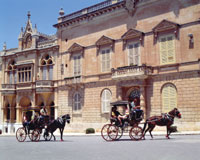
You haven’t been to Malta if you haven’t been to…
Mdina
Malta's first capital city during the time of the Knights of Malta, and also a colonial settlement of Imperial Rome.
It has been nicknamed The Silent City. Here one can visit palaces such as - The Magisterial Palace, Palazzo Gatto Murina, Palazzo Falzon, Palazzo Santa Sofia, Casa Isabella and the Banca Giuratale.
Ggantija Temples
The Ggantija Temples are considered to be the oldest freestanding structures in the world. Excavated between 1816 and 1820, the complex comprises of two Neolithic temples dating from the third millennium BC (c. 3500BC).
St. John's Co-Cathedral
This splendid church was built between 1573 and 1577 during the reign of Gran Master Jean de la Cassiere. A baroque work of art in its architecture and sculptures, this Church boasts some of the most beautiful works of art by Mattia Preti and Caravaggio himself. This church is situated in the capital city Valletta.
Hagar Qim Temples
Sited on high ground, this temple complex is the most impressive on Malta. Moreover they were built unlike any other, with radiating oval rooms and gigantic blocks – the largest is some seven metres tall and weighs 20 tons.
Gozo
Gozo which in Maltese is called Ghawdex is a derivation of other names such as Gaulos. It has an area of 67 sqkm, is 14km long and seven km wide. With a coastline of 43km, it is the second largest Island of the Maltese archipelago that, together with the smaller isle of Comino is the main Island of Malta from the Republic of Malta. Gozo is popularly called The Island of Calypso, which is a nickname originating from the Greek mythological location of Ogygia referred to in Homer’s Odyssey. In this epic poem, the fabled island was controlled by the nymph Calypso, who detained the Greek hero Odysseus for seven long years as prisoners of love.
The Hypogeum
The Hypogeum, or underground cavity, is a unique monument and a splendid example of architecture in the negative. It was discovered accidentally in 1902 by a stone mason who was laying the foundations of some houses. The Hypogeum consists of halls, chambers and passages hewn out of the living rock and covering some 500mÇ. The rock-cut chambers are of a diverse shapes and sizes and finished to different standards of workmanship. The complex is grouped in three levels – the upper level (3600-3300 BC), the middle level (3300-3000 BC), and the lower level (3150 -2500 BC). The deepest room in the lower level is 10.6 metres under road surface. The upper level consists of a large hollow with a central passage and burial chambers cut on each side. One of the chambers still contains original burial deposits. The middle level consists of various chambers very smoothly finished, which give the impression of built masonry. The workmanship is all the more impressive when one considers that the chambers were meticulously carved using only flint and stone tools. Curvilinear and spiral paintings in red ochre are still visible in some areas.
